In January, Denver Broncos coach Mike Shanahan became the fifth coach in football history to win back-to-back Super Bowls. Kieran McConnellogue talked to the Denver Broncos’ coach.
One of the most recognizable football coaches in America became an anonymous tourist last summer when he took a golf vacation in the land of his ancestors. But things might be different the next time Denver Broncos coach Mike Shanahan returns to Ireland. When his team won its second-straight Super Bowl on January 31, the coach’s face was seen by an estimated 800 million television viewers worldwide. The coverage spread even to Ireland where American football is becoming increasingly popular.
But if the Super Bowl champion coach is now a superstar he can be assured that in Ireland he will be treated like any other visitor. As the past few years have proved for an ever-rising influx of Hollywood stars — it’s the perfect place for an unbothered vacation from celebrityhood. During the summer of 1998. Shanahan discovered that for himself when he and his star quarterback John Elway enjoyed a rare break from the spotlight. The two football heroes, who are also good friends, were rarely bothered — but it’s not clear whether that was due more to their relative anonymity in Ireland or the native propensity towards leaving celebrities well enough alone.
“When we were in Ireland, I don’t think that there was anyone who recognized either of us, except maybe at Royal County Down, where there were a couple of caddies who were football fans,” recalls the personable coach.
The two men went into restaurants and pubs unnoticed, a luxury rare for Shanahan and almost unheard-of for Elway. For once the boot was firmly on the other foot — instead of being besieged by autograph hunters, it was Shanahan who was the awestruck, tongue-tied fan, surrounded by faces he could have sworn he recognized. As he traveled the country, he saw people who “looked identical” to his father and brother, he recounts. The familial likeness was far from coincidental; Shanahan’s great-grandparents emigrated to the United States from Counties Cork and Mayo in the latter part of the 19th century.
Shanahan may have managed to keep a low profile in Ireland, but things are different in the United States, and especially in Colorado, for the Irish American who guided the Broncos to back-to-back Super Bowl victories over the past two years — one of only five coaches to accomplish such a feat.
In 1998, his team delivered a 31-24 victory over the Green Bay Packers in what many consider the best Super Bowl ever, and with the 34-19 win over the Atlanta Falcons this January the Broncos became one of only six teams to win consecutive Super Bowl titles.
At 5-foot-11 and still close to the 175 pounds of his playing days in college, the 46-year-old Shanahan is physically unimposing. But his eyes shine with the intensity that has driven his team to the highest level of football success. The Broncos’ performance over the past three years, 47-9 (including the Super Bowl wins), is a record in the history of the NFL, and will stand as the perfect symbol of a team manifesting the personality of its head coach — maintaining discipline, focus, preparation, mental toughness and physical effort.
Shanahan’s brilliant success has thrust the low-key coach into a spotlight that continues to shine brightly. The golfing vacation in Ireland was a rare, and relaxing, chance to catch a breath. It was also his first visit to his great-grandparents’ homeland.
“It was something I was really looking forward to, to see the place where my great-grandparents came from, to see the lifestyle and experience the people,” he says. “I don’t think I’ve ever met people as nice as the people I met there. They were very genuine, very easy to talk to and very caring.”
Perhaps most important, he was just another Shanahan in a country full of them, not the famous coach of the Super Bowl winner. He was able to relax and enjoy some of Ireland’s scenic and exacting golf courses, including Portstewart and Portrush. The atmosphere made the normally fierce competitor relax his attitude.
“The great part about it was that if I played poorly, I could go to the pub and enjoy myself afterward,” he said. “I’d just have an extra Guinness.”
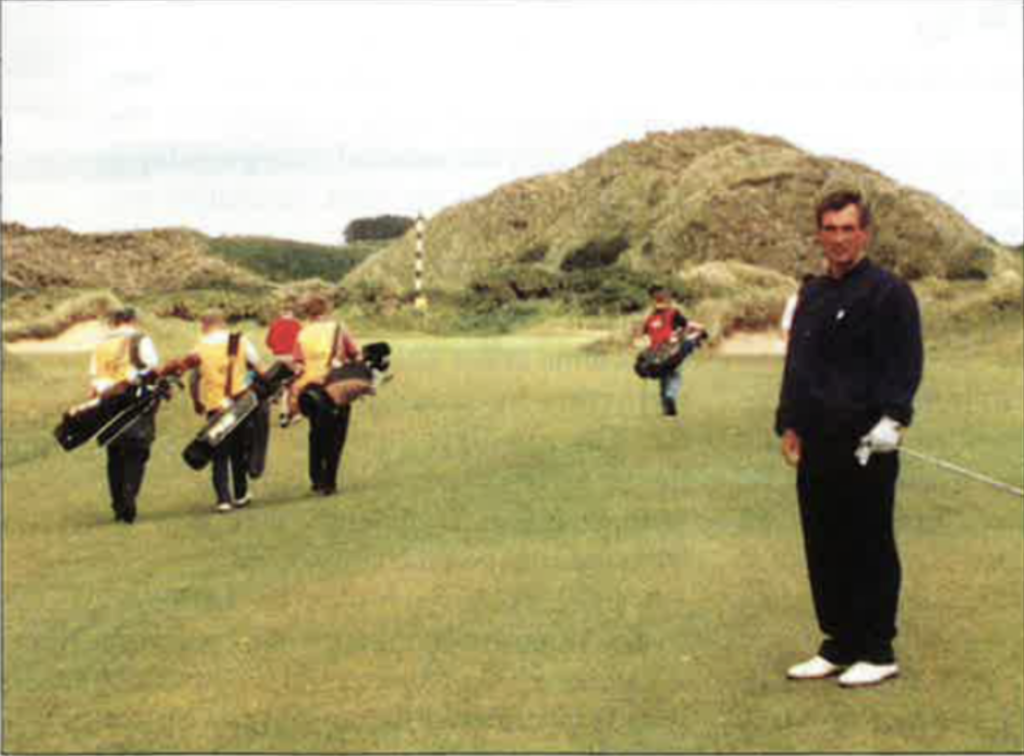
Things haven’t often gone poorly for Shanahan, either on the golf course, the football field or the rest of his life.
The oldest of six children, he was voted athlete of the year as well as most valuable player in both football and track at East Leyden High School in Franklin Park, a blue-collar town outside Chicago. His schooldays single-game rushing record of 258 yards still stands. Despite his small size, his grit and prowess earned him a scholarship to Eastern Illinois University.
While playing quarterback in a spring game, a hit on an option play left him woozy. He didn’t think much of it until after the game, when blood in his urine and searing pain sent him to the hospital. His heart stopped at one point. A priest gave him last rites. But doctors diagnosed a ruptured kidney and removed it.
His playing days were over, but not his football career.
“He seems to have a follow-through type personality and it seemed to carry him a long way in the sports world,” said Ed Shanahan, Mike’s father. “Every time we thought we couldn’t expect any more out of him, he popped up with something that made us very proud.”
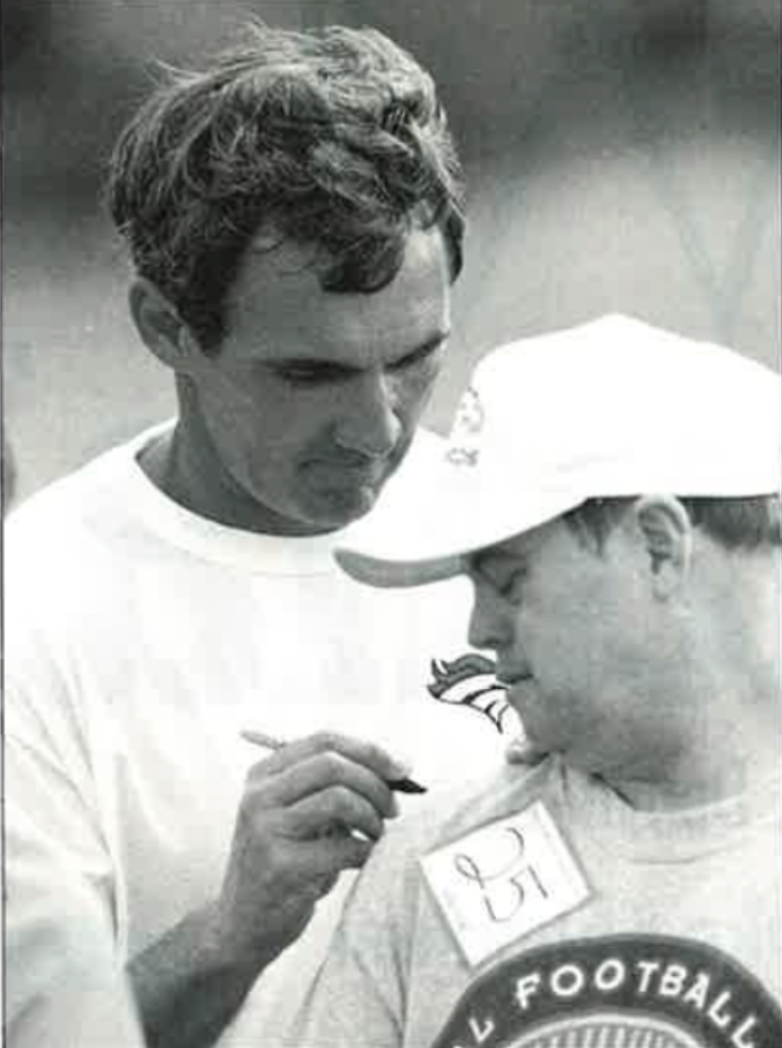
The elder Shanahan said his son Mike reminds him of his own brother, an Army Ranger who died at age 20 in the D-Day assault on Normandy.
“He was just a tough Irish kid, probably a better athlete than Mike. It was sad that his life was cut short before he could realize his dreams,” recalls Ed Shanahan.
The Shanahans emigrated to America in the late 1800s and settled in the Chicago area. Mike Shanahn’s great-grandmother came from County Mayo and great-grandfather came from County Cork. Both died young, as did Shanahan’s grandparents. But the family retained a strong sense of where they came from, according to Ed.
“We’ve always been very proud of our Irish heritage,” he attests. The father and son share an ability to focus combined with an affability that has served Mike well in his coaching career, whether at the college or professional level. “I attribute a lot to my dad and the way he was,” the younger Shanahan says. Married to Peggy, and the father of two grown children, Kyle and Krystal, he credits a combination of two Irish traits — a genial nature and passionate intensity — as a key to his success.
“Everybody needs to be themselves, but I think one of my traits is that I’ve always been able to get along with people,” he muses. “At the same time, some people say I’m too intense.”
His talent and personality made him rise quickly through the hierarchical world of football coaching and earned him recognition as one of the game’s most dynamic offensive minds.
Success seems to find teams where Shanahan coaches. After he earned a bachelor’s and master’s degree from Eastern Illinois, he landed his first coaching job in 1975 as the offensive backfield and receivers coach for the University of Oklahoma. The Sooners won the national championship in his first year on the staff. Shanahan was just 22.
After a year as backfield coach at Northern Arizona University, he returned to his alma mater as offensive coordinator, a position he seemed especially suited for. The previous year, the Panthers of Eastern Illinois had a record of 1-10. With Shanahan’s guidance, they won the Division II national championship.
In 1979, he moved back to the Division I level as offensive coordinator of a University of Minnesota team that would set 40 school records on offense. His last stop as a college coach was the University of Florida, where he helped guide the Gators to four straight bowl games and build the team into an offensive powerhouse.
“I don’t think I’ve ever met people as nice as the people I met there. They were very genuine, very easy to talk to and very caring.”
– Coach Shanahan on his trip to Ireland.
It didn’t take long for professional football teams to recognize Shanahan’s ability. In 1984, then 32, he became the receivers coach for the Denver Broncos. His talent for developing potent offenses quickly became apparent. He was promoted to offensive coordinator the following year. Although he was close to Elway, Shanahan’s offensive vision wasn’t given full reign under then-Broncos coach Dan Reeves, who didn’t easily cede the reins of the team’s offense.
Shanahan’s first shot at head coach status came at age 35 in 1988 with the Los Angeles Raiders, the Broncos’ bitter division rival. But he was fired after less than two unsuccessful seasons chafing under Al Davis, the controlling Raiders’ owner. He returned to the Broncos as quarterbacks coach and later offensive coordinator. Despite helping the team reach another Super Bowl, Shanahan was fired by Reeves after the 1991 season.
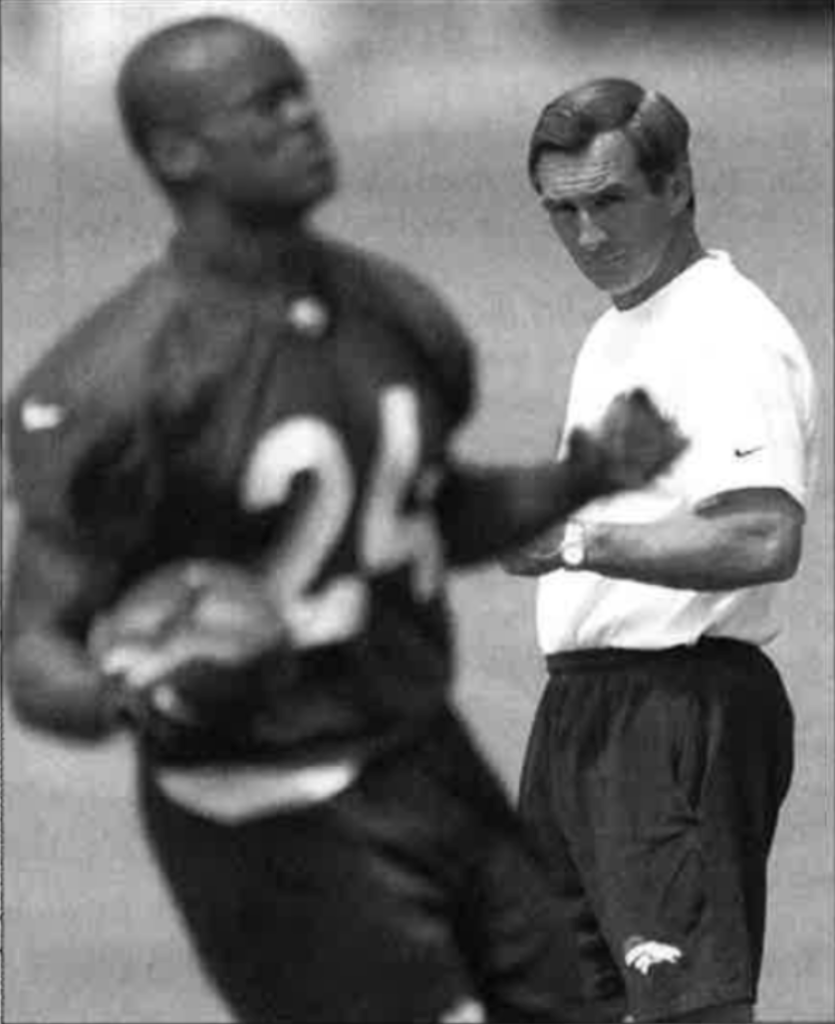
He bounced back quickly, however, when the San Francisco 49ers named him their offensive coordinator in 1992. Once again, he created a high-powered offense that took San Francisco to victory in the 1994 Super Bowl. Shanahan was a hot commodity among teams looking for a coach. It was then that Broncos owner Pat Bowlen realized he had better not let the young, talented coach get away again. He was hired as Broncos head coach in 1995.
The Broncos management recognized Shanahan’s brilliance last fall with a contract that makes him the highest-paid coach in the league (at $2.4 million a year), and ensures that he will remain among the top five in salary over the seven-year life of the contract.
The past two seasons have been a dream for Shanahan and the Broncos, but as recently as 1996, the team was struggling through a nightmarish run of bad luck. The Broncos had rolled through the season with a record of 13-3, among the league’s best. By the first round of the playoffs, they had been stopped in their tracks. A 30-27 win by the Jacksonville Jaguars, a lowly regarded wild-card team, cut deep with Shanahan and drove his determination to even greater levels throughout the off-season.
The Broncos came back in 1997 to win nine of their first ten games and finished 12-4. They earned a playoff spot as a wild card and set the stage for the “Revenge Tour,” a chance to settle scores with three teams that had dealt them painful losses during the season.
First up in the 1997 playoffs was the Jaguars, who came to Mile High Stadium in Denver with another upset in mind. But the Broncos, the 1996 loss still stinging, won handily. Next they took to the road to beat the Kansas City Chiefs and Pittsburgh Steelers to earn a berth in the fifth Super Bowl in franchise history.
They faced the heavily favored, defending-champion Green Bay Packers in San Diego and scored the get-ahead touchdown with less than two minutes remaining. Holding a furious last-minute drive by the Packers at bay, the Broncos claimed then’ first world championship with a performance reflecting the style of their coach — potent offense and hard-nosed defense. Shanahan called the victory the “ultimate” and took off on the whirlwind that swept up the team. Nearly 650,000 people celebrated with a parade and rally in Denver. The months after the game were a blur of speaking engagements, charity events and a trip to the White House to receive congratulations from President Clinton.
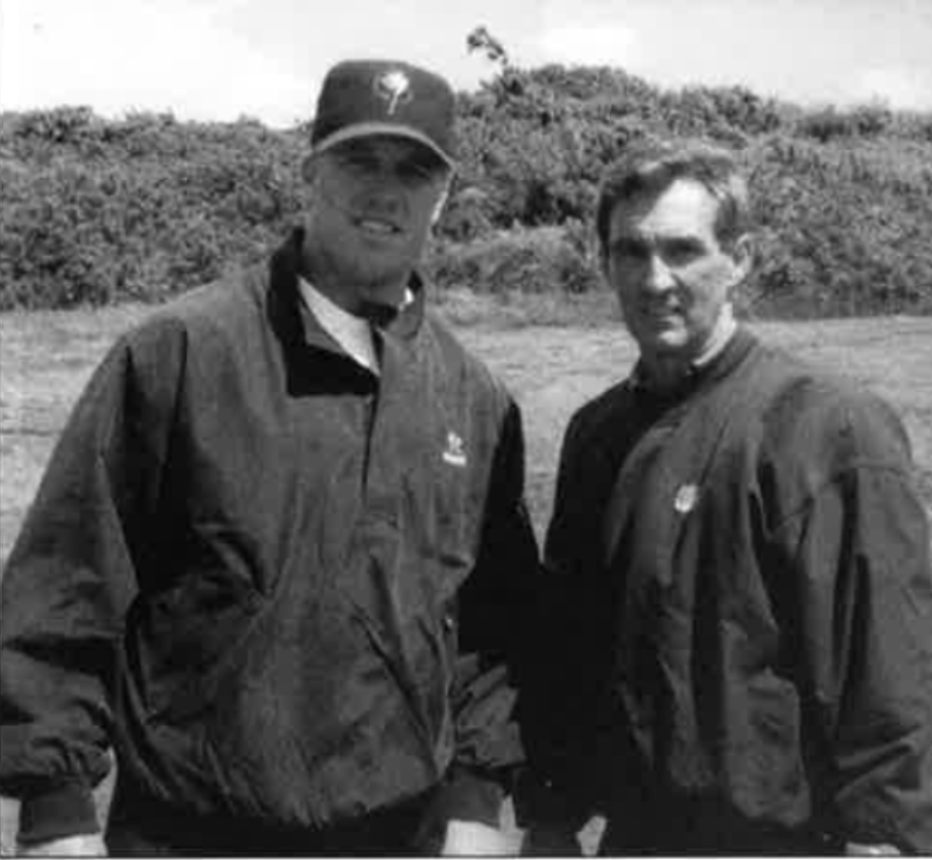
The 1997 victory was a tough act to follow, but Shanahan and his team came through again in 1998. They won their first 13 games and flirted with an undefeated season before losing to the New York Giants at the Meadowlands. The Broncos finished 14-2 and earned homefield advantage in the playoffs, a powerful benefit with Denver’s thin air and raucous fans at Mile High Stadium. They used strong defense, Elway’s passing and Davis’s running to beat the Miami Dolphins and New York Jets and head for their second-straight Super Bowl.
The game in Miami matched Shanahan with his former boss Dan Reeves, who hired Shanahan in 1984 and fired him in 1991 for what Reeves called insubordination. Reeves himself was fired by the Broncos in 1993 and much was made of the feud leading up to the Super Bowl, but the game ultimately proved anticlimactic.
The favored Broncos outplayed the Falcons and won easily. The 38-year-old Elway was named the game’s Most Valuable Player in his fifth appearance as a starting quarterback and Shanahan became the first Irish American to join the ranks of a select group of coaches who have won Super Bowls in consecutive years — Chuck Noll, Vince Lombardi, Don Shula and Jimmy Johnson. “It’s just nice to be mentioned with some of the other guys,” he said.
In his victory speech minutes after the game Shanahan made light of his propensity for preparation when he jokingly told his team that off-season conditioning started “tomorrow.” With two Super Bowl wins under his belt and his sights set on a record third, Shanahan can enjoy his success, and if he wants to get away from it all he knows he can always be sure of a great golf game in Ireland. Anonymity may be a little harder to come by this time, however. ⬥
Editor’s Note: This article was originally published in the April / May 1999 issue of Irish America.

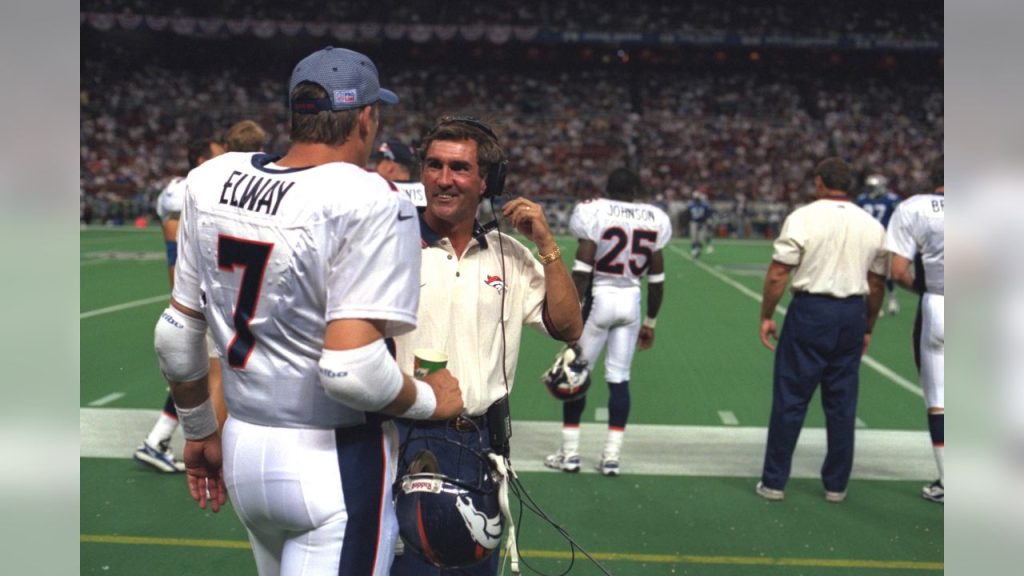
Leave a Reply